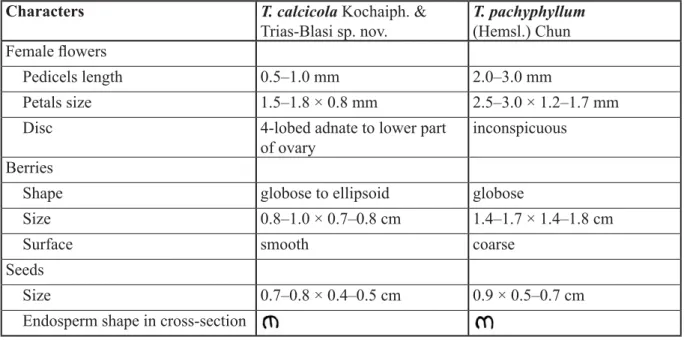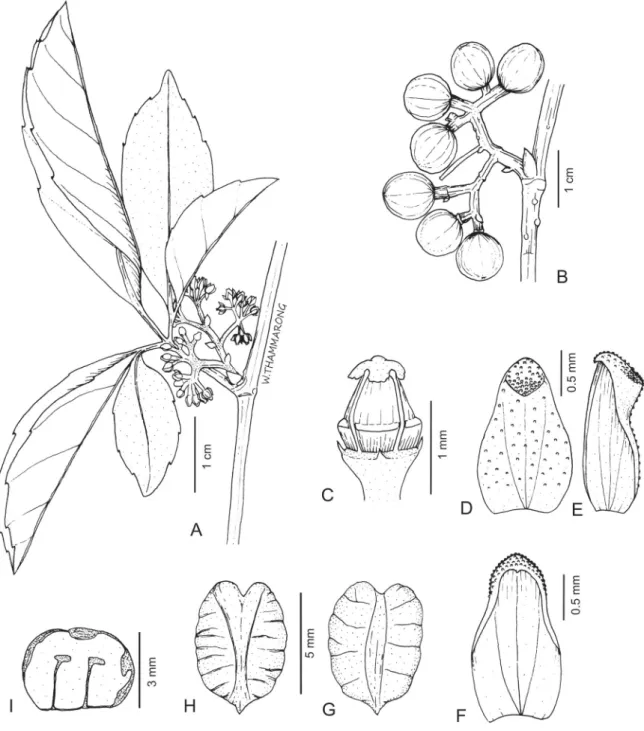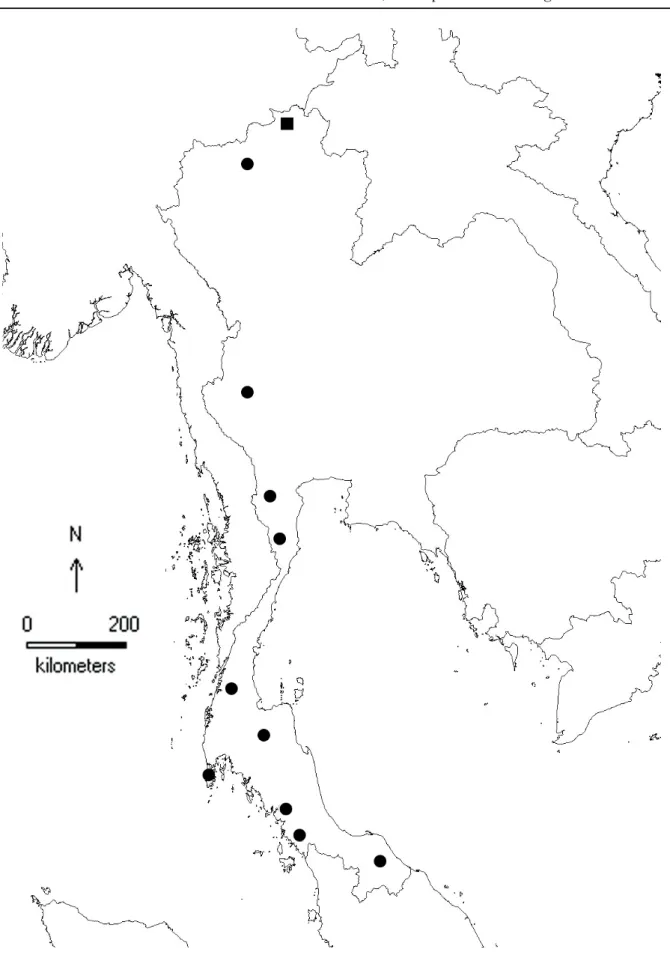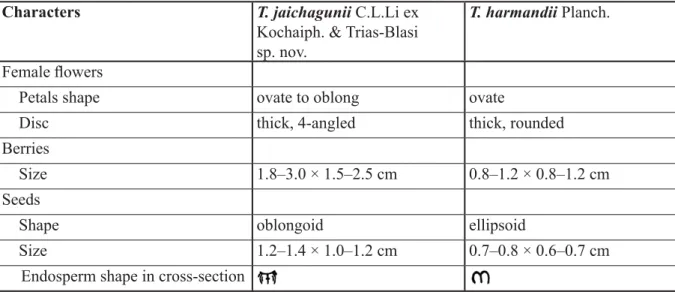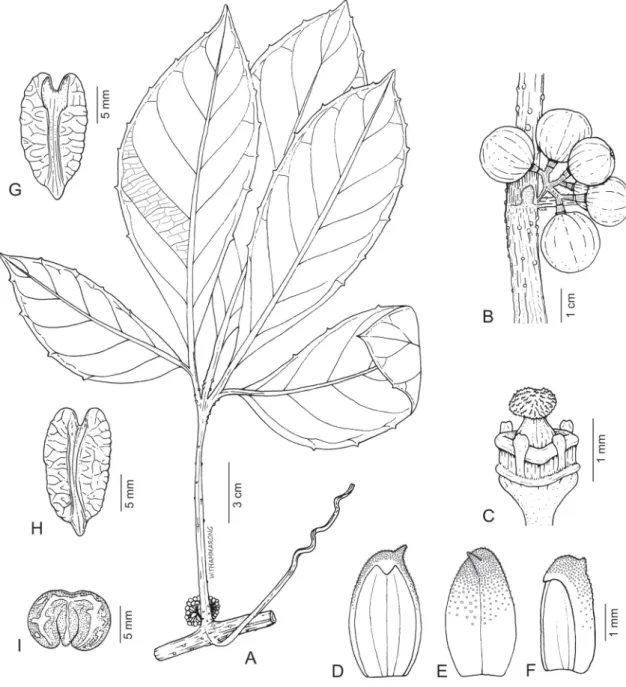http://dx.doi.org/10.5852/ejt.2016.201 www.europeanjournaloftaxonomy.eu 2016 · Kochaiphat P. et al.
This work is licensed under a Creative Commons Attribution 3.0 License.
R e s e a r c h a r t i c l e
Two new species of Tetrastigma (Miq.) Planch. (Vitaceae) from Thailand
Phongsakorn KOCHAIPHAT1, Anna TRIAS-BLASI2
& Pimwadee PORNPONGRUNGRUENG3,*
1,3 Applied Taxonomic Research Center, Department of Biology, Faculty of Science, Khon Kaen University, Khon Kaen 40002, Thailand.
2 Royal Botanic Gardens Kew, Richmond, Surrey TW9 3AE, England, U.K.
* Corresponding author: ppimwa@kku.ac.th
1 Email: phongsakorn.s@gmail.com
2 Email: a.triasblasi@kew.org
Abstract. Two new species of Tetrastigma from Thailand, T. calcicola Kochaiph. & Trias-Blasi sp. nov.
and T. jaichagunii C.L.Li ex Kochaiph. & Trias-Blasi sp. nov. are described and illustrated. Tetrastigma calcicola sp. nov. is a slender climber restricted to the open areas on limestone mountains at high elevation in the northern part of Thailand. The other species, T. jaichagunii sp. nov., is similar to T. harmandii Planch., but differs from it by having more densely verrucose young branches, broader leafl ets, 4-lobed thick discs, bigger globose berries and oblongoid seeds. This species occurs along streams or in forest margins in evergreen forest and it is widely distributed in several parts of Thailand.
Keywords. Tetrastigma, taxonomy, Thailand, revision, Vitaceae.
Kochaiphat P., Trias-Blasi A. & Pornpongrungrueng P. 2016. Two new species of Tetrastigma (Miq.) Planch.
(Vitaceae) from Thailand. European Journal of Taxonomy 201: 1–12. http://dx.doi.org/10.5852/ejt.2016.201
Introduction
Tetrastigma Planch. (Vitaceae) is a genus comprising approximately 95 species, distributed in tropical and subtropical Asia with a few of them reaching Australia (Planchon 1887; Latiff 1983; Chen et al.
2011; Trias-Blasi et al. 2012; Wen 2007). It can be easily distinguished from other genera of Vitaceae by its polygamo-dioecy, 4-merous fl owers, 4-lobed or 4-parted stigma, and absent or very short styles.
Twenty-six species have been recorded in Thailand (Kochaiphat et al. 2014), of which fi ve are endemic.
During preparation of the revision of Tetrastigma for the Flora of Thailand account, the first author came across several specimens collected from Doi Tung and Tham Luang Khun Nam Nang Non Forest Park (Chiang Rai province) with a unique combination of characters that did not match any previously described species.
In addition, a number of specimens representing a distinct taxon were found. Some were annotated as Tetrastigma jaichagunii by the late Prof. C.L. Li, however, no formal description had been published
for this name. Therefore, this species is described here as new species and the name T. jaichagunii is applied.
Material and methods
This study is based on the investigation of the herbarium specimens from relevant major herbaria as well as fi eld collections and observations in Thailand. Herbarium specimens from the following herbaria were examined: AAU, ABD, BCU, BK, BKF, BM, C, CMU, CMUB, E, K, KKU, L, P, PSU, QBG and TCD. The herbarium abbreviations follow Thiers (continuously updated). Voucher specimens collected from fi eld surveys were made following the method of Bridson & Forman (1989) and were deposited at KKU, BKF and QBG. The vegetative parts were measured in a dry state. Reproductive parts were rehydrated by boiling in water. Measurements were made under light microscope. The morphological terminology generally follows Beentje (2010), Wen (2007) and Jackes (1989); and for berry and seed terminology follows Latiff (1983) and Chen & Manchester (2011).
Taxonomy
Class Equisitopsida C.Agardh (Agardh et al. 1825) Subclass Magnoliidae Novák ex Takht. (Takhtajan 1967)
Superorder Rosanae Takht. (Takhtajan 1967)
Order Vitales Juss. ex Bercht. & J.Presl (Berchtold & Presl 1820) Family Vitaceae Juss. (Jussieu 1789) nom. cons.
Genus Tetrastigma (Miq.) Planch. (Planchon 1887)
Two Tetrastigma from Thailand, T. calcicola sp. nov. and T. jaichagunii sp. nov., are described herein as new species. Accordingly, the key to Tetrastigma in Thailand (Kochaiphat et al. 2014) has been revised from couplet 16 as follows.
Key to the species of Tetrastigma in Thailand
1. Tendrils 5–7 palmately branched; leaves palmately 3-foliolate ... T. triphyllum (Gagnep.) W.T.Wang – Tendrils simple or bifurcate; leaves simple, palmately 3‒5(‒7)-foliolate or pedately 5‒7(‒9)-foliolate
... 2
2. Infl orescences on old stems (caulifl orous plants), more than 5 infl orescences per nodes ... ... T. caulifl orum Merr. – Infl orescences on young branches, 1‒3 infl orescences per nodes ... 3
3. Young branches with 4‒5 sharp ridges ... T. quadrangulum Gagnep. & Craib – Young branches round or nearly round ... 4
4. Leaves palmately 3‒5(‒7)-foliolate or mixed with simple leaves or all leaves simple ... 5
– Leaves pedately 5‒7(‒9)-foliolate rarely mixed with 3-foliolate ... 16
5. Stems verrucose or with corky protuberances ... 6
– Stems smooth, pubescent or with fl aky cork ... 8
6. Stems with corky protuberances; leaves ovate to elliptic; stigma distinctly 4-lobed ... 7 – Stems verrucose; leaves lanceolate; stigma peltate ... T. harmandii Planch.
7. Leaves fl eshly; stigma cruciform; berries ellipsoid when dry ... T. cruciatum Craib & Gagnep.
– Leaves coriaceous or papyraceous; stigma pointed lobes; berries pyriform when dry ...
... T. assimile (Kurz) C.L.Li ex Kochaiph. & Trias-Blasi
8. Shrubs, creeping, erect or decumbent ... 9
– Lianas ... 10
9. Leaves simple or mixed with palmately 3(‒5)-foliolate; pedicel 0.4‒0.6 cm long ... ... T. bambusetorum Craib – Leaves palmately 3-foliolate; pedicel 0.8–1.2 cm long ... T. apiculatum Gagnep. 10. Leafl ets glabrous ... 11
– Leafl ets pubescent or hirsute at least along the midrib on lower leaf surface ... 15
11. Female fl ower disc conspicuous, thick and adnate to lower part of ovary ... 12
– Female fl ower disc inconspicuous ... 14
12. Terminal leafl ets broadly elliptic to rhombic; berries pyriform when dry ... ... T. pedunculare (Wall. ex M.A.Lawson) Planch. – Terminal leafl ets elliptic, ovate or lanceolate; berries ellipsoid when dry ... 13
13. Leaves coriaceous or subcoriaceous ... T. erubescens Planch. – Leaves papyraceous ... T. dubium (M.A.Lawson) Planch. 14. Leafl ets broadly ovate or broadly elliptic, apex caudate ... T. campylocarpum (Kurz) Planch. – Leafl ets lanceolate, apex attenuate ... T. planicaule (Hook.f.) Gagnep. 15. Ovary brownish hirsute; leaves palmately 5-foliolate ... T. obovatum (M.A.Lawson) Gagnep. – Ovary glabrous; leaves palmately 3-foliolate ... T. dubium (M.A.Lawson) Planch. 16. Leaves 5-foliolate, rarely mixed with 7-foliolate ... 17
– Leaves 7(‒9)-foliolate, rarely mixed with 5-foliolate ... 29
17. Branches glabrous; leafl ets glabrous on both surfaces ... 18
– Branches more or less pubescent; leafl ets pubescent at least along the midvein on lower leaf surface ... 26
18. Secondary branches of peduncle 2 ... T. baenzigeri C.L.Li – Secondary branches of peduncle more than 2 ... 19
19. Berries pyriform or triangular when dry ... 20
– Berries globose, ovoid or ellipsoid when dry ... 21
20. Terminal leafl ets ovate–lanceolate, 3–4 × 6–9 cm; berries pyriform when dry ... T. pyriforme Gagnep. – Terminal leafl ets obovate or elliptic, 4‒5.5 × 9‒12 cm; berries triangular when dry ... ... T. rumicispermum (M.A.Lawson) Planch. 21. Infl orescences compound umbel on pseudo-terminal branch or axile, umbelliform, loose; tendrils bifurcate ... T. serrulatum (Roxb.) Planch. – Infl orescences compound umbel on axile, globose, compact; tendrils unbranched ... 22
22. Female fl ower disc inconspicuous ... T. pachyphyllum (Hemsl.) Chun – Female fl ower disc conspicuous, thick and adnate to lower part of ovary ... 23
23. Stigma peltate, rounded or slightly 4-lobed ... 24
– Stigma cruciform, 4-lobed, obtuse, acute or pointed apex ... 25
24. Berries 1.8–3.0 × 1.5–2.5 cm; seed oblongoid; female fl ower disc 4-angled ...
... T. jaichagunii C.L.Li ex Kochaiph. & Trias-Blasi sp. nov.
– Berries 0.8–1.2 × 0.8–1.2 cm; seed ellipsoid; female fl ower disc rounded ... T. harmandii Planch.
25. Stigmas 4 acute or pointed lobes, style tubular 0.5–0.8 mm long ... T. dubium (M.A.Lawson) Planch.
– Stigmas 4 obtuse lobes, style absent ... T. calcicola Kochaiph. & Trias-Blasi sp. nov.
26. Leafl ets broadly elliptic or ovate ... 27 – Leafl ets narrowly elliptic or lanceolate ... T. dubium (M.A.Lawson) Planch.
27. Leafl ets pubescent along nerve or at least along the midrib on the lower surface ... 28 – Leafl ets pubescent on both surfaces ... T. macrocorymbum Gagnep. ex J.Wen 28. Berries up to 1.5 cm in diameter ... T. pilosum C.L.Li – Berries more than 2 cm in diameter ... T. siamense Gagnep. & Craib 29. Berries 2‒2.5 cm in diameter ... T. teaniatum C.L.Li – Berries 0.8‒1.5 cm in diameter ... 30 30. Outer petals densely papillose ... T. leucostaphylum (Dennst.) Alston ex Mabb.
– Outer petals glabrous ... 31 31. Secondary vein almost 90° with midrib; old branches verrucose, light brown; stigma 4 pointed lobes
... T. delavayi Gagnep.
– Secondary vein angle nearly 45° with midrib; old branches fl aky, grey; stigma 4 rounded lobes or nearly globose, not lobed ... T. godefroyanum Planch.
Tetrastigma calcicola Kochaiph. & Trias-Blasi sp. nov.
Table 1, Figs 1–2
urn:lsid:ipni.org:names:77155114-1
Diagnosis
Tetrastigma calcicola sp. nov. is most closely aligned to T. pachyphyllum (Hemsl.) Chun, but differs in having a 4-lobed disc adnate to the lower part of the ovary, and small berries with a smooth surface (Table 1).
Etymology
The specifi c epithet refers to the habitat of this species, which is only found on limestone mountains.
Type materials Holotype
THAILAND: Chiang Rai, Tham Luang Khun Nam Nang Non Forest Park, 21 Mar. 2011, M. Norsaengsri
& N. Tathana 7810, ♀ fl . (holo-: QBG!).
Paratype
THAILAND: Chiang Rai, Tham Luang Khun, Nam Nang Non Forest Park, 10 Jul. 2012, M. Norsaengsri
& N. Tathana 9736, ♀ fr. (QBG).
Description
Slender climber. Stems terete, young branches terete, verrucose; mature stems corky; tendrils simple;
stipules 2, deltate, c. 0.2 × 0.2 cm long, scale-like with age. Leaves compound, 3-foliolate or pedately 5-foliolate; petiole 0.8–5.0 cm long, glabrous, base slightly pulvinate; leafl ets coriaceous; terminal leafl et petiolule 0.2–2.0 cm long, glabrous, terminal leafl et blade elliptic, obovate to oblanceolate, 2.0–8.0 × 1.0–3.5 cm, base cuneate, margins serrate with minute protruding vein tip, apex acute to acuminate, petiolules of lateral leafl et complex 0.1–1.0 cm long, glabrous, lateral leafl et petiolules, sessile to 0.6 cm long, glabrous, lateral leafl et blade elliptic, obovate to oblanceolate, 1.0–5.5 × 0.5–2.8 cm, base cuneate or asymmetrical, margins and apex as for terminal leafl et; veins conspicuous on lower sides, midrib protruding on both surfaces, glabrous, 1 main basal vein, 4–7 pairs of lateral veins. Infl orescences axillary on young stem, 1–2 per node, compound umbel, male plant not seen; female plant 1.0–2.5 cm in diameter, compact, globose; peduncles 0.3–1.0 cm, rarely puberulous. Female fl owers’ bud ovoid, 1.0–1.5 mm long; pedicels 0.5–1.0 mm long, papillose; calyx disciform, margins entire, papillose; petals ovate, 1.5–1.8 × 0.8 mm, apex slightly corniculate, outer surface densely papillose, margins entire;
disc 4-lobed adnate to lower part of ovary; staminode clavate, c. 1.2 mm long; ovary conical, c. 0.8 × 0.8 mm; style sessile; stigma cruciform, 4-lobed, lobes obtuse, ciliate. Berries globose to ellipsoid, 0.8–1.0 × 0.7–0.8 cm, surface smooth, yellow or white when ripe, 1–3-seeded. Seeds ellipsoid, 0.7–0.8 × 0.4–0.5 cm, testa transversely rugulose on both sides, adaxial surface with a Y shaped furrow, abaxial surface with an oblong chalaza, endosperm ‘ ’ shaped in cross-section.
Distribution
Known only from Thailand (Fig. 2).
Ecology and phenology
In open area on limestone mountain, dry evergreen forest, altitude 1,300–1,450 m; fl owering: February–
March; fruiting: July–October.
Characters T. calcicola Kochaiph. &
Trias-Blasi sp. nov.
T. pachyphyllum (Hemsl.) Chun Female fl owers
Pedicels length 0.5–1.0 mm 2.0–3.0 mm
Petals size 1.5–1.8 × 0.8 mm 2.5–3.0 × 1.2–1.7 mm
Disc 4-lobed adnate to lower part
of ovary
inconspicuous Berries
Shape globose to ellipsoid globose
Size 0.8–1.0 × 0.7–0.8 cm 1.4–1.7 × 1.4–1.8 cm
Surface smooth coarse
Seeds
Size 0.7–0.8 × 0.4–0.5 cm 0.9 × 0.5–0.7 cm
Endosperm shape in cross-section
Table 1. Main morphological differences between T. calcicola Kochaiph. & Trias-Blasi sp. nov. and T. pachyphyllum (Hemsl.) Chun.
Fig. 1. Tetrastigma calcicola Kochaiph. & Trias-Blasi sp. nov. A. Branch and female infl orescence.
B. Infructescence. C. Ovary. D. Corolla, dorsal view. E. Corolla, lateral view. F. Corolla, ventral view.
G. Seed, dorsal view. H. Seed, ventral view. I. Seed, transversal section. Drawn by Woranart Thammarong.
A, C–F from M. Norsaengsri & N. Tathana 7810; B from R. Pooma 1186; G–I from M. Norsaengsri &
N. Tathana 9736.
Fig. 2. Distribution of Tetrastigma calcicola Kochaiph. & Trias-Blasi sp. nov. (■) and T. jaichagunii C.L.Li ex Kochaiph. & Trias-Blasi sp. nov. (●).
Additional specimens examined
THAILAND. Chiang Rai:Doi Tung, 22 Oct. 1995, R. Pooma 1186, ♀ fr. (BKF, CMUB); ibid., 18 Feb.
2005, J.F. Maxwell 05-147, ♀ fl . (CMUB).
Conservation status
We suggest to treat this species as Data Defi cient (DD) according to IUCN (2012), as this species is only known from a few herbarium specimens and only two localities have been recorded: Doi Tung and Tham Luang Khun Nam Nang Non Forest Park in Chiang Rai Province. Although the species seems to occur only in limestone mountains at high elevation, the number of populations and their sizes are not known so far.
Tetrastigma jaichagunii C.L.Li ex Kochaiph. & Trias-Blasi sp. nov.
Table 2, Figs 2–3
urn:lsid:ipni.org:names:77155116-1
Diagnosis
This species is similar to T. harmandii Planch., but differs from it by having more densely verrucose young branches, broader leafl ets, 4-lobed thick discs, bigger globose berries and oblongoid seeds (Table 2). Some specimens were misidentifi ed as T. hookeri Planch., an Indian species, but T. hookeri has narrow leaves and an inconspicuous disc in female fl owers.
Etymology
We think that Prof. C.L. Li selected the specifi c epithet ‘Jaichagunii’ in honour of Mr Manit Jaichagun, from the CITES Scientifi c Authority in Thailand.
Type materials Holotype
THAILAND. Trang, Khao Chong, 12 Mar. 1974, K. Larsen & S.S. Larsen 33238, ♀ fl . (holo-: AAU!, iso-: BKF!, L!, P!).
Paratypes
THAILAND. Phetchaburi, Kaeng Krachan National Park, 3 Aug. 1995, K. Larsen, S.S. Larsen, C.
Tange, R. Moran & P. Puudjaa 45370, ♀ fr. (AAU); Satun, Ta Le Bun, 26 Nov. 1985, J.F. Maxwell 85- 1060, ♀ fr. (L).
Description
Large climber. Stems fl attened with age, young branches terete, verrucose; mature stems corky; tendrils simple; stipules 2, deltate, c. 0.4 × 0.3 cm, reduced to scale-like with age. Leaves compound, 3-foliolate or pedately 5(–7)-foliolate; petioles 4.0–19.0 cm long, verrucose, base pulvinate; leafl ets papyraceous to subcoriaceous; terminal leafl et petiolule, 1–5.0 cm long, glabrous, terminal leafl et blade lanceolate, elliptic, to oblanceolate, 11.5–33.0 × 3.5–12.0 cm, base obtuse to cuneate, margins coarsely serrate with c.
0.5 protruding vein tip, apex acuminate to caudate, petiolules of lateral leafl et complex 1.0–3.5 cm long, glabrous, lateral leafl et petiolules, sessile–2.5 cm long, glabrous, lateral leafl et blade lanceolate, elliptic to broadly elliptic, oblong, 8.5–30 × 2.5–11.5 cm, base obtuse to cuneate or asymmetrical, margins and apex as terminal leafl et; veins conspicuous on lower sides, midrib protruding on both surfaces, glabrous, 1 main basal vein, 6–13 pairs of lateral veins. Infl orescences axillary on young stem, single, compound umbel; 2–3 cm in diameter, compact, umbelliform; peduncles 0.5–1.0 cm, puberulent, male plant not seen. Male fl owers not seen. Female fl owers’ bud ovoid, 2.0–3.0 mm long; pedicels 2.0–3.0 mm long, papillose; calyx disciform to cupuliform, margins undulate, ciliate; petals ovate to oblong, 2.2–3.0 ×
1.5–1.8 mm, apex hooded, outer surface densely papillose, margins entire; disc thick, 4-angled, adnate to ovary; staminode clavate–trullate, 0.5–1.0 mm long; ovary conical, 1.0–1.2 × 1.0–1.5 mm; style cylindrical, c. 0.5 mm long; stigma peltate, round or slightly 4-lobed, ciliate. Berries globose, 1.8–3.0
× 1.5–2.5 cm, surface smooth, green when young, yellow when ripe, 1–4-seeded. Seeds oblongoid, 1.2–1.4 × 1.0–1.2 cm, testa transversely rugose on both sides, adaxial surface with an oblong furrow, abaxial surface with a linear chalaza, apex bilobed, apical notch 1.0–3.0 mm, endosperm ‘ ’ shaped in cross-section.
Distribution
Known only from Thailand (Fig. 2).
Ecology and Phenology
Along streams or in forest margins in evergreen forest; altitude 0–1,500 m; fl owering: January–April;
fruiting: June–January.
Additional specimens examined
THAILAND. NORTHERN: Chiang Mai: Chiang Mai, along the road, 40 km to Pai, 17 Sep. 1995, K. Larsen, S.S. Larsen, C. Tange & D. Sookchaloem 46583, ♀ fl . (AAU); Chiang Dao, 26 Dec. 1940, H.B.G. Garrett 1214, ♀ fr. (TCD, L, P); Doi Chiang Dao, 13 Jul. 1950, H.B.G. Garrett 1336 (P, L, K);
ibid., 18 Dec. 1951, H.B.G. Garrett 1374 (P, L, K); ibid., 22 Jan. 1989, J.F. Maxwell 89-0081, ♀ fr.
(L); Hang Dong, Mae Khanin, 7 Mar. 1999, S. Watthana & W. Pongamornkul Wat. 240, ♀ fl . (QBG);
Mae Tang, 19 Nov. 1990, J.F. Maxwell 90-1259, ♀ fr. (CMU); Mae Tang, Pa Pae, 17 Sep. 1995, BGO.
Staff. 4507 (QBG); SOUTH-WESTERN: Kanchanaburi: Between Kriti and Mueang Cha, 9 Jul. 1973, R. Geesink & C. Phengklai 6220, ♀ fr. (AAU, BKF, E, L, P); Thung Yai Naresuan, 11 Aug. 1992, J.F.
Maxwell 93-869, ♀ fr. (CMUB); Thong Pha Phum, Thung Yai Naresuan, 10 Jun. 2002, M. Van De Bult 565, ♀ fr. (BKF, CMUB); Phetchaburi: Kaeng Krachan National Park, 26 Aug. 1995, J.A.N. Parnell, J.
Pendry & T. Boonthavikoon 95-450, ♀ fr. (K); ibid., 25 Jun. 2000, M.F. Newman, T. Boonthavikoon, C.
Hemrat & D.J. Middleton 1040, ♀ fr. (AAU, BKF, L, P); ibid., 9 Aug. 2002, D.J. Middleton, S. Suddee, S.J. Davies & C. Hemrat 888, ♀ fr. (BKF, CMUB); Prachuap Khiri Khan: Kaeng Krachan National Park, Pa La-u Waterfalls, 14 Aug. 2002, D.J. Middleton, S. Suddee, S.J. Davies & C. Hemrat 1060, ♀
Characters T. jaichagunii C.L.Li ex Kochaiph. & Trias-Blasi sp. nov.
T. harmandii Planch.
Female fl owers
Petals shape ovate to oblong ovate
Disc thick, 4-angled thick, rounded
Berries
Size 1.8–3.0 × 1.5–2.5 cm 0.8–1.2 × 0.8–1.2 cm
Seeds
Shape oblongoid ellipsoid
Size 1.2–1.4 × 1.0–1.2 cm 0.7–0.8 × 0.6–0.7 cm
Endosperm shape in cross-section
Table 2. Main morphological differences between T. jaichagunii C.L.Li ex Kochaiph. & Trias-Blasi sp. nov. and T. harmandii Planch.
fr. (BKF, CMUB); PENINSULAR: Ranong: Klong Naka National Park, 24 Nov. 1974, R. Geesink, P.
Hiepko & C. Charoenpol 7519, ♀ fr. (BKF, K); ibid., 7 Jan. 1990, S. Hoover 5048, ♀ fr. (E); ibid., 8 Jan. 1990, S. Hoover 5481, ♀ fr. (E); ibid., 13 Jan. 1990, S. Hoover 6329, ♀ fr. (E); Khao Po Ta Luang Kaeo, 31 Jan. 1929, A.F.G. Kerr 16912, ♀ fl . (L, P); No locality, 22 Jan. 1929, A.F.G. Kerr 16805A (BK, K); Kapoe, 15 Jul. 1979, C. Niyomdham et al. 320, ♀ fr. (AAU, BKF, K, L, P); Khao Po Ta Luang Kaeo, 11 Dec. 1979, T. Shimizu, H. Toyokuni, H. Koyama, T. Yahara & C. Niyomdham T-26922 (AAU, BKF, L); Surat Thani: Klong Phanom National Park, 21 Mar. 2005, S. Gardner, P. Sidisunthorn &
P. Tippayasri ST1875, ♂ fl . (QBG); Phangnga: Khao Po Ta Luang Kaeo, 2 Feb. 1929, A.F.G. Kerr
Fig. 3. Tetrastigma jaichagunii C.L.Li ex Kochaiph. & Trias-Blasi sp. nov. A. Branch and female infl orescence. B. Infructescence. C. Ovary. D. Corolla, ventral view. E. Corolla, dorsal view. F. Corolla, lateral view. G. Seed, ventral view. H. Seed, dorsal view. I. Seed, transversal section. Drawn by Woranart Thammarong. A, C–F from K. Larsen & S.S. Larsen 33238; B from K. Larsen et al. 4537; G–I from J.F.
Maxwell 85-1060.
16990, ♀ fl . (BK, BM, K, L); Phuket: Kathu, 12 Mar. 1929, A.F.G. Kerr 17463 (BK, K); Nakhon si thammarat: Ka Rom Waterfalls, 14 Apr. 1985, J.F. Maxwell 85-0396, ♀ fl . (BKF, L); ibid., 30 Oct.
1993, K. Larsen, S.S. Larsen, C.T. Norgaard, K. Pharsen, P. Puudjaa & W. Ueachirakan 44163, ♀ fr.
(AAU); Tha Sala, 2 Mar. 1986, J.F. Maxwell 86-0111, ♀ fl . (BKF, L); Thung Song, 19 Jul. 1929, Rabil 93, ♀ fr. (BK, L); Phatthalung: Khao Pu Khao Ya National Park, 16 Nov. 1990, K. Larsen, S.S. Larsen, W. Nanakorn, W. Ueachirakan & P. Sirirugsa 41534, ♀ fl . (AAU, K); Trang: Khao Chong, 13 Jun.
1974, R. Geesink, T. Hattink & C. Charoenpol 7181, ♀ fr. (BKF, K); ibid., 10 Jul. 2000, D.J. Middleton, T. Boonthavikoon, S.J. Davies, C. Hemrat & M.F. Newman 373, ♀ fr. (AAU, BKF); Pa Liang, 24 Apr. 1931, M.C. Laksanakarn 791, ♀ fl . (L, K); Sai Rung Waterfalls, 15 Mar. 2006, S. Gardner & V.
Chamchaumroon ST2480, ♀ fl . (QBG); Satun: Ko Ta Ru Tao, 19 Jan. 1918, A.F.G. Kerr 14188, ♀ fl . (BM, K); Klong Ton, 11 Mar. 1928, A.F.G. Kerr 14469, ♀ fl . (L, K); Yala: Bang Lang National Park, 12 Feb. 2004, D.J. Middleton, M. Phuphat, R. Pooma & K. Williams 3011, ♂ fl . (BKF, E); no locality, 25 Mar. 1998, C. Niyomdham 5331, ♀ fl . (BKF, K).
Conservation status
This species has rather large populations and is widely distributed in several parts of the country.
Therefore, it is considered Least Concern (LC).
Discussion
Tetrastigma calcicola sp. nov. and T. jaichagunii sp. nov. are distinct from the other previously described species. The major characters for recognising the species are female fl owers and fruits. Tetrastigma calcicola sp. nov. differs from its closest relative, T. pachyphyllum, by its 4-lobed disc that is adnate to the lower part of the ovary, and small berries with a smooth surface. Tetrastigma jaichagunii sp. nov. can be separated from T. harmandii by its more densely verrucose young branches, broader leafl ets, 4-lobed thick discs, bigger globose berries and oblongoid seeds.
Currently, these two new species are known only from Thailand. Tetrastigma calcicola sp. nov. is restricted to limestone mountains at high elevation in the northern part of Thailand, while T. jaichagunii sp. nov. has a wider range of distribution. The latter species has only been recorded from evergreen forest in several parts of Thailand in large populations. However, it seems possible that it might be found in neighbouring countries such as Myanmar or Laos if a more extensive fi eld survey is carried out in the future.
Acknowledgements
This work was supported by the Graduate School, Khon Kaen University and Science Achievement Scholarship of Thailand (SAST). The fi rst author would like to thank Prof. Dr. John A.N. Parnell and other staff at TDC for their kind help and also grateful to the staff of AAU, ABD, BCU, BK, BKF, BM, C, CMU, CMUB, E, K, KKU, L, P, PSU, QBG and TCD for their help and for the loan of/or access to specimens. Thanks to Mr. Woranart Thammarong for the illustrations.
References
Agardh C.A., Holmberg L.P. & Lundstrom P.M. 1825. Classes Plantarum. Literis Berlingianis, Lundae [Lund]. http://dx.doi.org/10.5962/bhl.title.7657
Beentje H. 2010. The Kew Plant Glossary. Kew Publishing, Kew, UK.
Berchtold B.V. von & Presl J.S. 1820. O př irozenosti rostlin, aneb rostliná r, obsahugjcj: gedanj on žiwobytj rostlinné m pro sebe a z ohledu giný ch žiwoků , podlé stawu nyně gssjbo zná nj; k rozssjř enj
př irodnictwj; w potaženj na užiteć nost w rolnictwj, hospodá ř stwj, ř emestech, umě nj i obchodu a w wztahowá nj obzwlá sstnjm na lekař stwj. Enders, Prague.
Bridson D. & Forman L. 1989. The Herbarium Handbook. Royal Botanic Gardens, Kew, London.
Chen P., Chen L. & Wen J. 2011. The fi rst phylogenetic analysis of Tetrastigma (Miq.) Planch, the host of Raffl esiaceae. Taxon 60 (2): 499–512.
Chen I. & Manchester S.R. 2011. Seed morphology of Vitaceae. International Journal of Plant Science 172 (1): 1–35. http://dx.doi.org/10.1086/657283
IUCN 2012. IUCN Red List Categories and Criteria: Version 3.1. Second edition. IUCN, Gland, Switzerland and Cambridge, UK.
Jackes B.R. 1989. Revision of the Australian Vitaceae, 5. Tetrastigma (Miq.) Planchon. Austrobaileya 3 (1): 149–158.
Jussieu A.L. de 1789. Genera plantarum, secundum ordines naturales disposita, juxta methodum in horto regio Parisiensi exaratam. Herissant & Barrois, Paris. http://dx.doi.org/10.5962/bhl.title.7762 Kochaipat K., Trias-Blasi A. & Pornpongrungrueng P. 2014. A new combination and new records of Tetrastigma (Vitaceae) from Thailand. Phytotaxa 183 (4): 272–278. http://dx.doi.org/10.11646/
phytotaxa.183.4.6
Latiff A. 1983. Studies in Malesian Vitaceae VII. The genus Tetrastigma in the Malay Peninsula.
Gardens’ Bulletin Singapore 36 (2): 213–228.
Planchon J.E. 1887. Monographie des Ampélidées vrais. In: de Candolle A.F.P.P. & de Candolle C. (eds) Monographiae Phanaerogamarum. Vol. 5, part 2: 305–654. G. Masson, Paris.
Takhtajan A.L. 1967. Sistema i filogeniia tsvetkovykh rastenii (Systema et Phylogenia Magnoliophytorum). Soviet Science Press, Leningrad & Nauka, Moscow.
Thiers B. Continuously updated. Index Herbariorum: a global directory of public herbaria and associated staff. New York Botanical Garden’s Virtual Herbarium [online]. Available from http://sweetgum.nybg.
org/ih/ [accessed 9 Oct. 2015].
Trias-Blasi A., Parnell J.A.N. & Hodkinson T. 2012. Multi-gene region phylogenetic analysis of the grape family (Vitaceae). Systematic Botany 37 (4): 941–950. http://dx.doi.org/10.1600/036364412X656437 Wen J. 2007. Vitaceae. In: Kubitzki K. (ed.) The Families and Genera of Vascular Plants. Vol. 9: 467–
479. Springer-Verlag, Berlin.
Manuscript received: 14 October 2015 Manuscript accepted: 8 January 2016 Published on: 30 May 2016
Topic editor: Koen Martens Desk editor: Natacha Beau
Printed versions of all papers are also deposited in the libraries of the institutes that are members of the EJT consortium: Muséum national d’Histoire naturelle, Paris, France; Botanic Garden Meise, Belgium;
Royal Museum for Central Africa, Tervuren, Belgium; Natural History Museum, London, United Kingdom; Royal Belgian Institute of Natural Sciences, Brussels, Belgium; Natural History Museum of Denmark, Copenhagen, Denmark.
